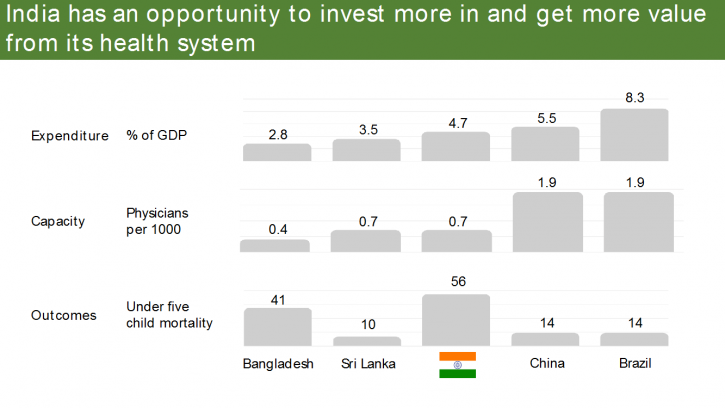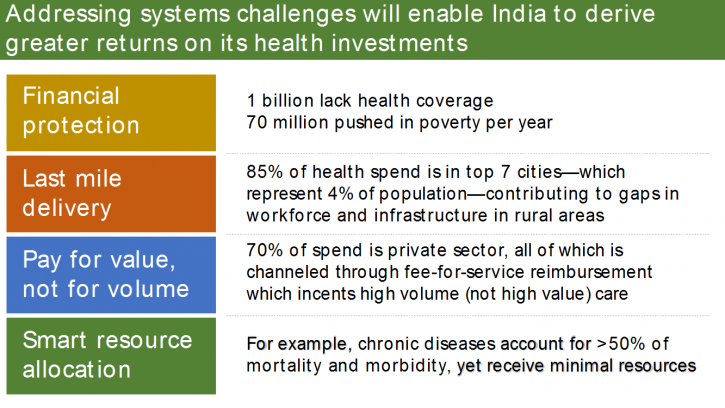India’s deep pool of entrepreneurs has launched countless disruptive businesses from the Bay Area to Bangalore. In this article, Chintan Maru explores the question − how can India attract this talent to tackle the country’s formidable public health challenges?
India’s health industry is projected to grow fourfold in one decade, from US$70 billion in 2011 to US$280 billion by 2020. Yet we have reason to question whether this tremendous investment will improve outcomes. In India’s booming corporate hospitals, physicians meet revenue targets by peddling procedures on questionable medical grounds, and in rural areas, countless ‘quack’ practitioners prescribe antibiotics and steroids for the common cold. The public sector, meanwhile, has made important investments in health insurance; yet these programmes cover hospital stays but not outpatient care, driving utilisation of high-cost acute care instead of prevention.
To achieve higher value healthcare, India will need to transform core elements of its health system: how money flows; how resources are distributed; what incentives motivate patients, providers, and payers. While the government leads health system design, the private sector can also play a role in shaping the system.
Figure 1. India’s health system: Expenditure, capacity, and outcomes
 Note: GDP (gross domestic product) data is from 2011 and remainder are World Bank's "most recent value" or MRV standard.
Note: GDP (gross domestic product) data is from 2011 and remainder are World Bank's "most recent value" or MRV standard. Entrepreneurs, with their capacity for rapid experimentation, are well-positioned to help determine how to increase health outcomes achieved per rupee invested. Yet left to market forces alone, entrepreneurs will not address these systems challenges. This article explores the question − how can India tap the potential of its entrepreneurs to address the country’s most important health systems challenges?
Corral resources around the biggest public health priorities
What the entrepreneurial ecosystem lacks is a sharp strategic focus. As a result, we see few startups tackling the most important health systems challenges. (Figure 2 offers preliminary hypotheses on what these priorities might be.) At least two factors drive this.
First, each of the dominant incubators and impact investors work across several sectors; perhaps this breadth has prevented them from articulating a public health strategy. They evaluate the existing pipeline of entrepreneurs and have a rigorous diligence to identify the highest potential among them. An implication of this approach is that their portfolios may generate reasonable returns, but their entrepreneurs may or may not address public health priorities. Second, left to market forces, entrepreneurs tend to develop point solutions − ones that address narrowly defined problems and do not require the involvement of complex stakeholder groups. While this reduces a business’s risk profile, it also limits its ability to influence a health system. It’s easier to design and deploy an app or medical device, for example, than to alter how physicians are incentivised.
To strengthen India’s social entrepreneurship ecosystem, there is an opportunity for leaders in the private, public, and social sectors to take a more proactive stance: to signal to entrepreneurs the highest priority challenges and then to corral resources around those priorities.
Figure 2. Highest priority challenges in the health system
 Note: GDP (gross domestic product) data is from 2011 and remainder are World Bank's "most recent value" or MRV standard.
Note: GDP (gross domestic product) data is from 2011 and remainder are World Bank's "most recent value" or MRV standard. Invest in and attract talent to businesses that serve the underserved
India has experienced a surge in startup-driven healthcare innovation. Healthspring is transforming primary care delivery. Life In Control is re-imagining how physicians and patients jointly manage chronic diseases. Practo is establishing a platform that mediates data, communication, and payments between payers, providers, and patients; and it may become the IT infrastructure on which a generation of startups builds new solutions. These enterprises make important contributions, but their reach is generally limited to the urban upper classes, where their investors see a clearer path to profitability.
There are glimmers of activity elsewhere that demonstrate how entrepreneurs can meet the needs of the underserved. LV Prasad Eye Institute provides world-class eye care for both rich and poor and is now extending its reach to rural areas. Noora Health empowers caregivers to support their sick family members in the hospital, reducing re-hospitalisation rates, and expanding the human resource capacity of short-staffed government hospitals. Incubators like Villgro and N/Core and impact investors like Aavishkaar and Unitus provide training and patient capital that enable social entrepreneurs to focus on serving poor communities. Efforts like these should be applauded and built upon.
Engage the government in the path to scale
Health systems, one might argue, should be designed by public sector players who are responsive and accountable to democratic governance. Yet organisational and political constraints often prevent those stakeholders from leading innovative efforts because they are inherently risky and require the latitude to learn, fail, and pivot.
The social entrepreneur is well-positioned to lead such innovation. But s/he, too, faces a dilemma: Who is the customer for social innovations intended to reach those at the ‘base of the pyramid’? In India, the government is meant to finance health for the poorest and therefore the entrepreneur who wants to tackle the most important health systems questions must recognise the role of government in its path to scale.
Two examples, both in their early stages, are testing the potential of private-public partnerships. Yeshasvini Health Scheme, a collaboration between Narayana Health and the government of Karnataka, is an insurance model that covers both inpatient care and outpatient consultation for farmers. The government of Jharkhand has collaborated with HealthMap Diagnostics to develop and manage a network of radiology providers across the state. Entrepreneurs will need to find new ways to engage the government for India to realise the full potential of healthcare entrepreneurship.
If India’s entrepreneurs begin to solve health systems challenges, their ventures can make important contributions at the global level. The heterogeneity of India’s health system provides a useful laboratory to test how new ideas perform in a variety of environments. It is home to megacities and one of the world’s largest rural populations. There are some states, like Uttar Pradesh, where healthcare is dominated by the private sector, and other states, like Andhra Pradesh, that are growing the role of the state government in healthcare. As a result, a new generation of entrepreneurs solving health systems challenges in India can generate insights useful in countries as varied as Nigeria, Indonesia, and Ethiopia.
The article first appeared in The Lancet: http://globalhealth.thelancet.com/2017/07/28/what-lies-ahead-role-entrepreneurship-indias-rising-public-health-sector.




 19 January, 2018
19 January, 2018 




By: Arvind Bhagwat 04 September, 2023
Excellent Write-up and Analysis Sir ! Being a Retired Pharma Professional , with an interest in Academics , find the gaps in Awareness & Healthcare Distribution inequality are the most crucial ones for the country to address